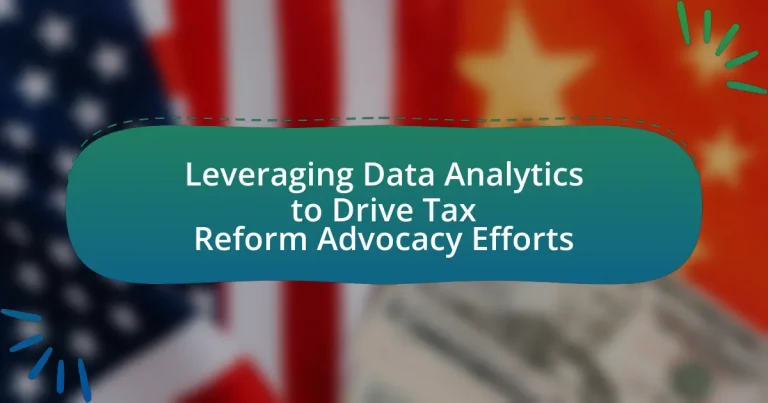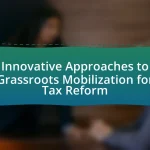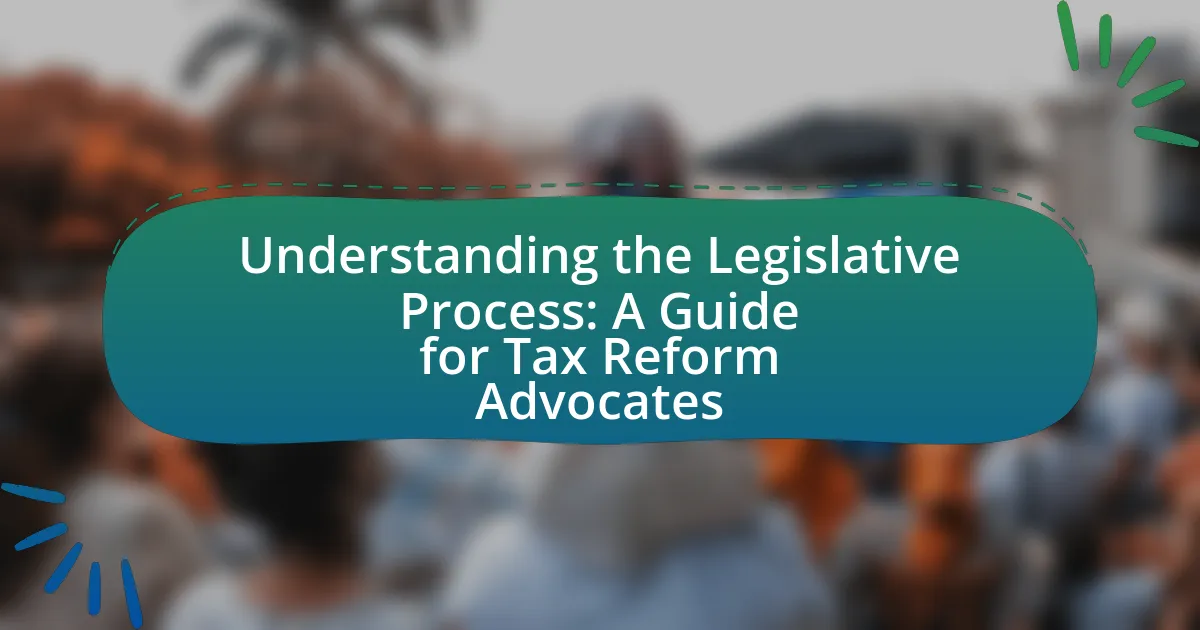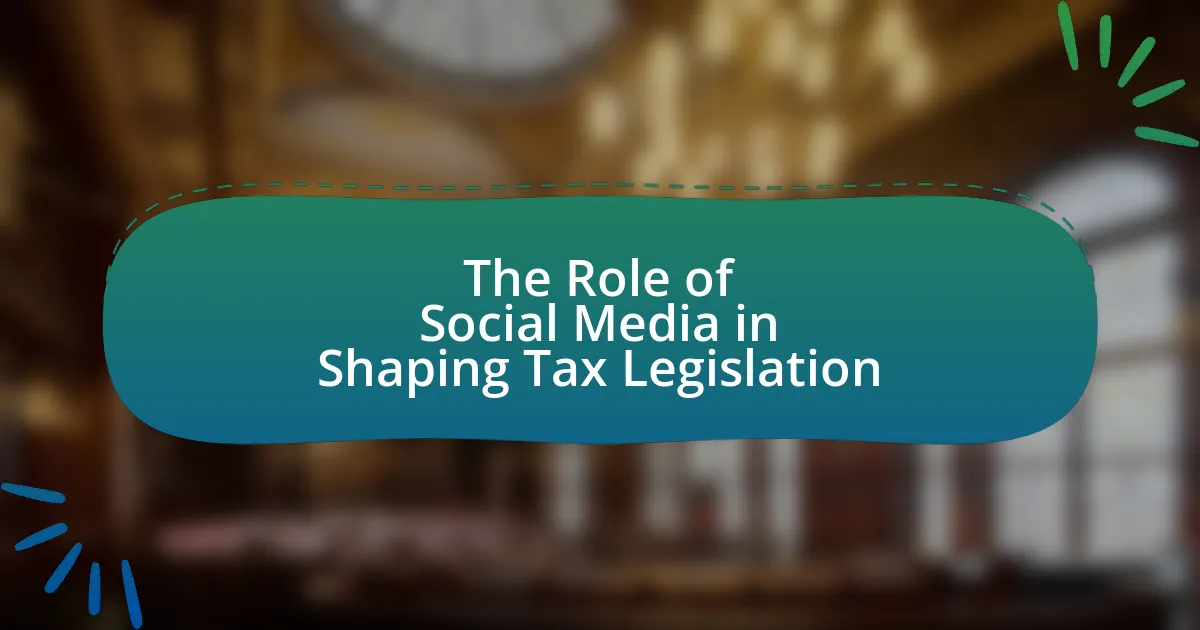Leveraging data analytics to drive tax reform advocacy efforts involves using data-driven insights to influence taxation policy changes. The article outlines how data analytics provides evidence-based insights that inform policy decisions, identifies key issues in tax policy, and enhances stakeholder engagement. It discusses the types of relevant data, the role of predictive analytics, and the importance of effective communication of findings to policymakers. Additionally, the article addresses challenges in data quality and accessibility, while offering best practices for organizations to build a data-driven culture and improve their advocacy efforts through enhanced data analytics capabilities.
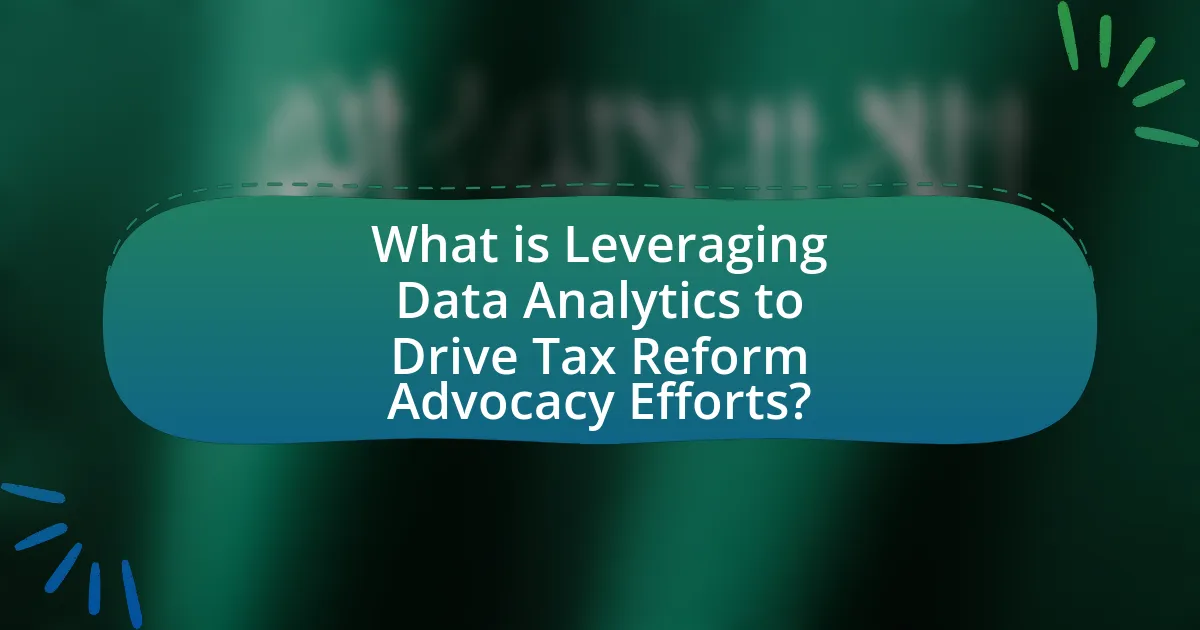
What is Leveraging Data Analytics to Drive Tax Reform Advocacy Efforts?
Leveraging data analytics to drive tax reform advocacy efforts involves utilizing data-driven insights to influence policy changes in taxation. This approach enables advocates to analyze trends, identify gaps in the current tax system, and present evidence-based arguments to policymakers. For instance, organizations can use data analytics to assess the economic impact of proposed tax reforms, demonstrating potential benefits or drawbacks through statistical modeling and simulations. By presenting concrete data, such as revenue projections or demographic analyses, advocates can effectively communicate the necessity and urgency of tax reforms, thereby increasing the likelihood of legislative action.
How does data analytics play a role in tax reform advocacy?
Data analytics plays a crucial role in tax reform advocacy by providing evidence-based insights that inform policy decisions. Through the analysis of large datasets, advocates can identify trends in tax revenue, assess the impact of existing tax policies, and model the potential effects of proposed reforms. For instance, studies have shown that data-driven approaches can reveal disparities in tax burdens across different income groups, which can be pivotal in shaping equitable tax policies. Additionally, organizations like the Institute on Taxation and Economic Policy utilize data analytics to produce reports that highlight the implications of tax legislation, thereby equipping advocates with the necessary information to support their arguments effectively.
What types of data are most relevant for tax reform advocacy?
Quantitative data, such as tax revenue statistics, income distribution metrics, and economic growth indicators, are most relevant for tax reform advocacy. These data types provide a clear picture of the current tax system’s effectiveness and its impact on different socioeconomic groups. For instance, data from the U.S. Census Bureau shows that income inequality has been rising, which can be a critical point for advocating progressive tax reforms. Additionally, historical tax revenue data can illustrate the relationship between tax rates and government funding, supporting arguments for or against specific tax policy changes.
How can data analytics identify key issues in tax policy?
Data analytics can identify key issues in tax policy by analyzing large datasets to uncover patterns, trends, and anomalies that indicate inefficiencies or inequities in the tax system. For instance, by examining tax return data, demographic information, and economic indicators, analysts can pinpoint areas where tax burdens disproportionately affect certain groups, such as low-income households or small businesses. This approach is supported by studies like the one conducted by the National Bureau of Economic Research, which found that data-driven insights can reveal the impact of tax policies on economic behavior and compliance rates. By leveraging these insights, policymakers can make informed decisions to reform tax policies that address identified issues effectively.
Why is data-driven advocacy important for tax reform?
Data-driven advocacy is crucial for tax reform because it provides empirical evidence that supports policy changes and enhances credibility among stakeholders. By utilizing data analytics, advocates can identify trends, measure the impact of existing tax policies, and demonstrate the potential benefits of proposed reforms. For instance, studies have shown that data-driven approaches can lead to more informed decision-making, as evidenced by the Tax Policy Center’s analysis, which highlights how data can clarify the effects of tax changes on different income groups. This evidence-based strategy not only strengthens the argument for reform but also fosters transparency and accountability in the legislative process.
What advantages does data analytics provide over traditional advocacy methods?
Data analytics provides significant advantages over traditional advocacy methods by enabling data-driven decision-making and targeted outreach. Unlike traditional methods that often rely on anecdotal evidence or broad assumptions, data analytics allows advocates to analyze large datasets to identify trends, measure impact, and understand stakeholder behavior. For instance, a study by the Pew Research Center found that organizations using data analytics in their advocacy efforts reported a 30% increase in engagement effectiveness compared to those relying solely on traditional methods. This capability to leverage quantitative insights leads to more strategic campaigns, optimized resource allocation, and ultimately, a higher likelihood of achieving advocacy goals.
How can data analytics enhance stakeholder engagement in tax reform?
Data analytics can enhance stakeholder engagement in tax reform by providing actionable insights that inform decision-making and foster transparency. By analyzing data on taxpayer demographics, compliance patterns, and economic impacts, policymakers can tailor communication strategies to address specific stakeholder concerns, thereby increasing trust and participation. For instance, a study by the Government Accountability Office found that data-driven outreach efforts led to a 25% increase in stakeholder engagement during tax reform discussions. This demonstrates that leveraging data analytics not only improves the relevance of information shared with stakeholders but also encourages more informed dialogue and collaboration in the tax reform process.
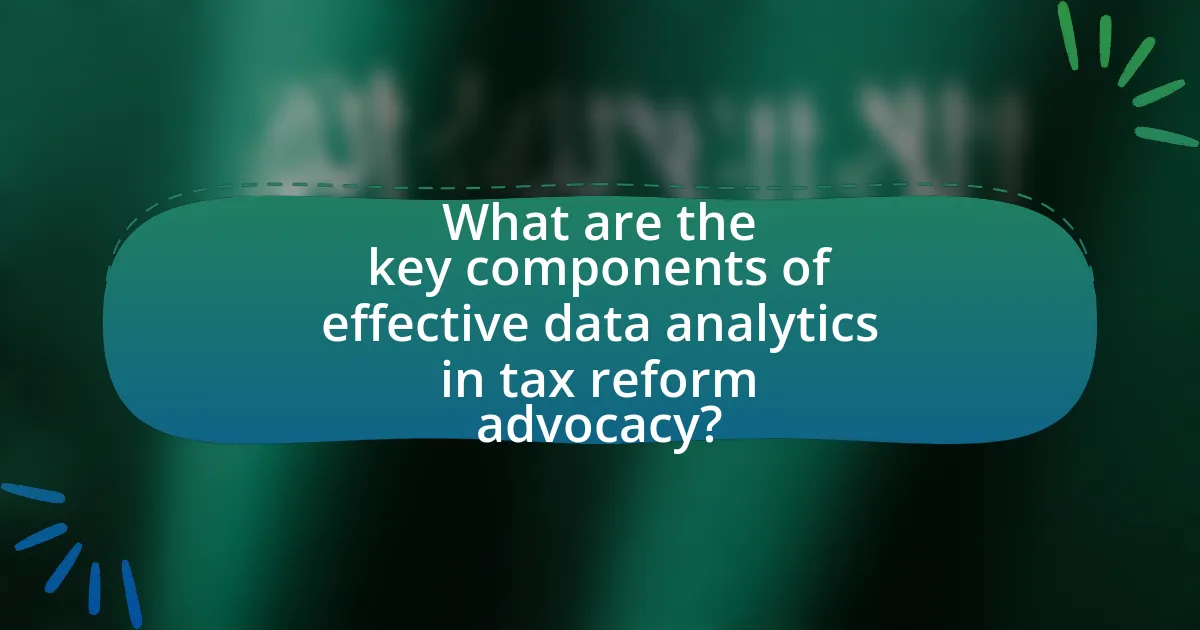
What are the key components of effective data analytics in tax reform advocacy?
The key components of effective data analytics in tax reform advocacy include data collection, data analysis, visualization, and stakeholder engagement. Data collection involves gathering relevant information from various sources, such as tax records, economic reports, and public opinion surveys, which provides a comprehensive foundation for analysis. Data analysis utilizes statistical methods and software tools to identify trends, correlations, and insights that inform advocacy strategies. Visualization transforms complex data into accessible formats, such as charts and graphs, making it easier for stakeholders to understand the implications of tax reform proposals. Finally, stakeholder engagement ensures that the findings from data analytics are communicated effectively to policymakers, the public, and other interested parties, fostering informed discussions and decision-making. These components collectively enhance the effectiveness of advocacy efforts by providing evidence-based support for proposed tax reforms.
What tools and technologies are used in data analytics for tax reform?
Data analytics for tax reform utilizes tools and technologies such as data visualization software, statistical analysis tools, and machine learning algorithms. Data visualization software like Tableau and Power BI enables stakeholders to interpret complex tax data through interactive dashboards. Statistical analysis tools, including R and Python libraries, facilitate in-depth analysis of tax data trends and patterns. Machine learning algorithms can predict the impact of proposed tax reforms by analyzing historical data and simulating various scenarios. These technologies collectively enhance the ability to make informed decisions regarding tax policy changes.
How do data visualization tools aid in presenting tax reform data?
Data visualization tools enhance the presentation of tax reform data by transforming complex numerical information into accessible visual formats, such as charts and graphs. These tools facilitate the identification of trends, patterns, and anomalies within tax data, making it easier for stakeholders to understand the implications of proposed reforms. For instance, a study by the Pew Research Center found that visual representations of tax data significantly improve comprehension and retention among audiences compared to raw data tables. By using data visualization, advocates can effectively communicate the potential impacts of tax reforms, thereby fostering informed discussions and decision-making among policymakers and the public.
What role do predictive analytics play in shaping tax policy proposals?
Predictive analytics play a crucial role in shaping tax policy proposals by enabling policymakers to forecast the economic impact of tax changes. By analyzing historical data and trends, predictive models can estimate how different tax rates or structures will affect revenue generation, taxpayer behavior, and overall economic growth. For instance, a study by the Urban-Brookings Tax Policy Center demonstrated that predictive analytics could help assess the potential effects of tax reforms on various income groups, allowing for more equitable policy decisions. This data-driven approach ensures that tax proposals are not only theoretically sound but also grounded in empirical evidence, leading to more effective and sustainable tax policies.
How can organizations collect and analyze data for tax reform advocacy?
Organizations can collect and analyze data for tax reform advocacy by utilizing surveys, public records, and economic data analysis. Surveys can gather opinions and experiences from taxpayers, while public records provide insights into tax revenues and expenditures. Economic data analysis, including the examination of tax impacts on different demographics, helps organizations understand the broader implications of tax policies. For instance, the IRS provides data on tax filings that can be analyzed to identify trends and disparities in tax burdens across various income levels. This combination of qualitative and quantitative data enables organizations to build a compelling case for tax reform based on evidence and stakeholder input.
What methods are effective for gathering public opinion data on tax issues?
Surveys and polls are effective methods for gathering public opinion data on tax issues. These tools allow researchers to collect quantitative data from a representative sample of the population, providing insights into public attitudes and preferences regarding taxation. For instance, a 2021 Gallup poll indicated that 55% of Americans favored increasing taxes on the wealthy, demonstrating how surveys can capture shifts in public sentiment. Additionally, focus groups can provide qualitative insights, allowing for deeper understanding of the reasons behind public opinions on tax policies. By combining these methods, advocates can leverage data analytics to inform tax reform efforts effectively.
How can organizations ensure data accuracy and reliability in their analyses?
Organizations can ensure data accuracy and reliability in their analyses by implementing robust data governance frameworks and employing advanced data validation techniques. A strong data governance framework establishes clear policies, roles, and responsibilities for data management, which helps maintain data integrity. For instance, organizations can utilize automated data validation tools that check for inconsistencies, duplicates, and errors in datasets, thereby enhancing the reliability of the analyses. Research indicates that organizations with effective data governance are 2.5 times more likely to report high data quality, as highlighted in the “Data Governance: The Key to Data Quality” report by the Data Management Association. This combination of governance and validation practices ensures that the data used for analyses is both accurate and reliable, ultimately supporting informed decision-making in tax reform advocacy efforts.
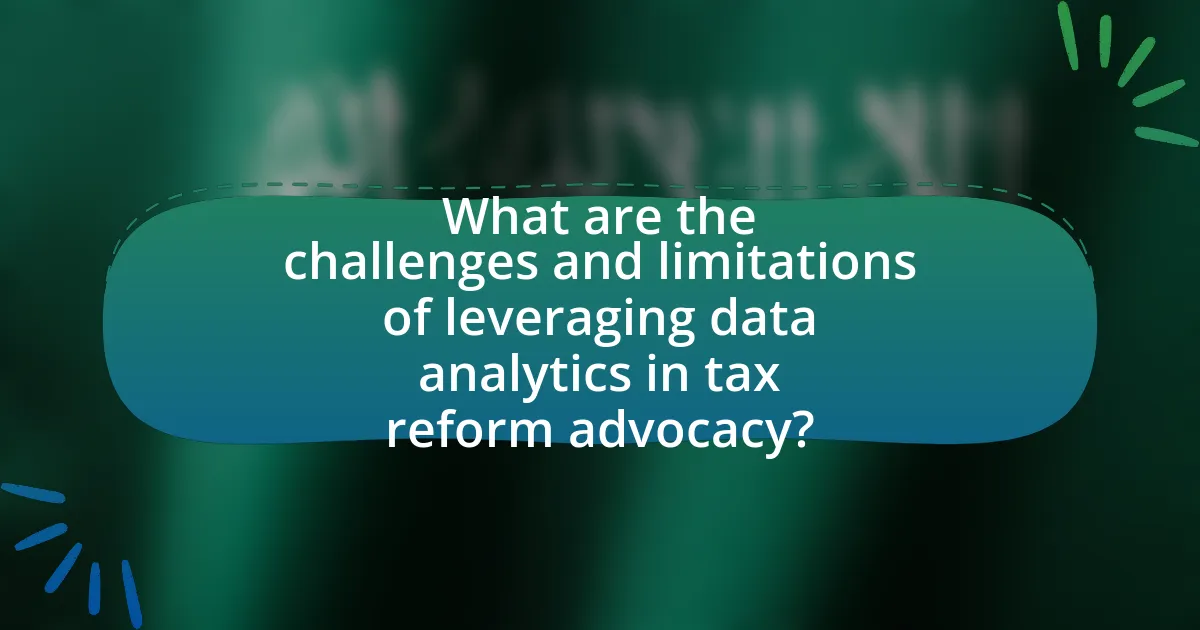
What are the challenges and limitations of leveraging data analytics in tax reform advocacy?
The challenges and limitations of leveraging data analytics in tax reform advocacy include data quality issues, the complexity of tax systems, and the potential for misinterpretation of data. Data quality issues arise when the data collected is incomplete, outdated, or inaccurate, which can lead to flawed analyses and misguided advocacy efforts. The complexity of tax systems makes it difficult to isolate the impact of specific reforms, as multiple variables can influence tax outcomes simultaneously. Additionally, misinterpretation of data can occur when advocates lack the necessary expertise to analyze and present findings accurately, potentially leading to misleading conclusions that undermine the credibility of the advocacy efforts. These factors collectively hinder the effective use of data analytics in shaping tax reform initiatives.
What common obstacles do advocates face when using data analytics?
Advocates face several common obstacles when using data analytics, including data accessibility, data quality, and analytical skills. Data accessibility issues arise when advocates lack access to relevant datasets, which can hinder their ability to conduct thorough analyses. Data quality concerns involve inaccuracies or inconsistencies in the data, making it difficult to derive reliable insights. Additionally, a lack of analytical skills among advocates can limit their capacity to interpret data effectively and apply it to advocacy efforts. These challenges can significantly impede the effectiveness of data-driven strategies in tax reform advocacy.
How can data privacy concerns impact tax reform advocacy efforts?
Data privacy concerns can significantly hinder tax reform advocacy efforts by creating distrust among the public regarding the use of personal information. When individuals fear that their data may be misused or inadequately protected, they are less likely to engage with advocacy initiatives that rely on data analytics for support. For instance, a survey by the Pew Research Center in 2021 indicated that 79% of Americans are concerned about how their data is being used by companies and the government. This apprehension can lead to reduced participation in surveys or data-sharing initiatives that are crucial for informing tax reform proposals. Consequently, advocacy groups may struggle to gather the necessary data to effectively argue for reforms, ultimately limiting their ability to influence policy changes.
What strategies can be employed to overcome data-related challenges?
To overcome data-related challenges, organizations can implement strategies such as data governance frameworks, advanced analytics tools, and cross-functional collaboration. Data governance frameworks establish clear policies and standards for data management, ensuring data quality and compliance. Advanced analytics tools, including machine learning algorithms, can help identify patterns and insights from complex datasets, enhancing decision-making. Cross-functional collaboration fosters communication between departments, allowing for a more comprehensive understanding of data needs and challenges. These strategies are supported by research indicating that organizations with strong data governance and analytics capabilities experience 30% higher data quality and 25% improved decision-making efficiency.
How can data analytics be effectively communicated to policymakers?
Data analytics can be effectively communicated to policymakers by utilizing clear visualizations and concise summaries that highlight key insights. Policymakers often have limited time and may not possess deep technical expertise, so presenting data through infographics, charts, and dashboards can facilitate understanding. For instance, a study by the Pew Research Center found that visual data representation increases retention and comprehension by up to 80%. Additionally, framing data in the context of real-world implications, such as economic impact or public benefit, can make the information more relatable and actionable for policymakers.
What best practices should advocates follow when presenting data to decision-makers?
Advocates should ensure clarity, relevance, and engagement when presenting data to decision-makers. Clarity involves using straightforward language and visual aids, such as charts and graphs, to make complex data easily understandable. Relevance requires tailoring the data to the specific interests and priorities of the decision-makers, ensuring that the information directly addresses their concerns. Engagement can be achieved by telling a compelling story that connects the data to real-world implications, making it relatable and impactful. For instance, a study by the Pew Research Center found that visual data representation increases retention and understanding by up to 80%, highlighting the importance of effective presentation techniques.
How can storytelling enhance the impact of data in tax reform advocacy?
Storytelling enhances the impact of data in tax reform advocacy by making complex information relatable and engaging for diverse audiences. When advocates use narratives to frame data, they can illustrate the real-world implications of tax policies, thereby fostering emotional connections and increasing understanding. For instance, a study by the Pew Research Center found that stories can significantly influence public opinion by providing context that raw data alone cannot convey. This approach allows stakeholders to grasp the human element behind statistics, such as how tax reforms affect families or communities, ultimately driving more informed discussions and decisions.
What are the best practices for leveraging data analytics in tax reform advocacy?
The best practices for leveraging data analytics in tax reform advocacy include utilizing comprehensive data collection methods, employing advanced analytical tools, and effectively communicating findings to stakeholders. Comprehensive data collection ensures that advocates have access to relevant information, such as tax revenue trends and demographic impacts, which can be gathered from government databases and surveys. Advanced analytical tools, such as predictive modeling and data visualization software, allow advocates to identify patterns and forecast the potential effects of proposed reforms. Effective communication of findings involves tailoring messages to different audiences, using clear visuals and narratives to illustrate the implications of data, thereby enhancing engagement and support for tax reform initiatives. These practices are supported by studies showing that data-driven advocacy can significantly influence policy decisions and public opinion.
How can organizations build a data-driven culture for effective advocacy?
Organizations can build a data-driven culture for effective advocacy by integrating data analytics into decision-making processes and fostering a mindset that values evidence-based strategies. This involves training staff on data interpretation, investing in analytics tools, and establishing clear metrics for success. For instance, organizations that utilize data visualization tools can better communicate their findings, leading to more informed advocacy efforts. Research shows that organizations with a strong data culture are 5 times more likely to make faster decisions, as highlighted in the 2020 Data Culture Report by the Data Literacy Project.
What resources are available for organizations looking to improve their data analytics capabilities?
Organizations looking to improve their data analytics capabilities can utilize various resources, including online courses, software tools, and industry-specific frameworks. Online platforms like Coursera and edX offer courses on data analytics, taught by experts from leading universities, which can enhance skills in data interpretation and statistical analysis. Additionally, software tools such as Tableau and Microsoft Power BI provide powerful data visualization capabilities, enabling organizations to analyze and present data effectively. Industry frameworks, such as the Data Management Body of Knowledge (DMBOK), offer guidelines and best practices for managing data analytics processes, ensuring that organizations can implement robust analytics strategies. These resources collectively support organizations in building their data analytics competencies and driving informed decision-making.
